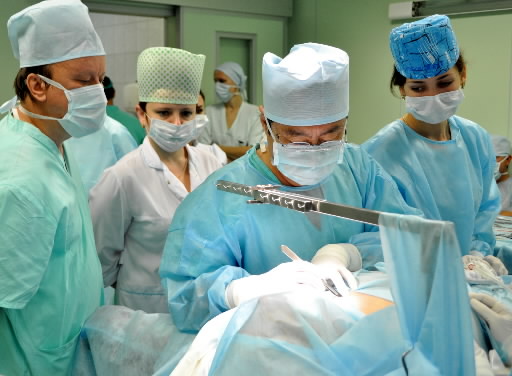Fukushima and Hiroshima: Lessons from Chernobyl, Part 6 [3]
Nov. 2, 2011
Article 3: Exposure to low doses of radiation
by Yo Kono, Staff Writer
Twenty years later cancer appears
In the province of Brest in southwest Belarus is the Endocrine Clinic of the Brest State Malignant Tumor Hospital. “Something has been bothering me recently,” said Arthur Grigorovich, 44, director of the clinic. For the past five years or so the incidence of thyroid cancer has been on the rise in areas where the dose of radiation is extremely low, he said, although more than 20 years have passed since the disaster at the nuclear power plant in Chernobyl.
Cases doubled in past 10 years
A total of 181 cases of thyroid cancer were documented in Brest province in 2010, approximately double the total 10 years ago. When broken down according to the location of the patients’ residences, the ratios were: high-dose areas: 30 percent; low-dose areas: 20 percent; and extremely low-dose areas: 40 percent. That is to say, the greatest number of cases occurred in the extremely low-dose areas. In the past residents in the high-dose areas represented the greatest number of cases, but the trend has reversed, the clinic director said.
Mr. Grigorovich has visited Hiroshima four times under the auspices of the Hiroshima International Council for Health Care of the Radiation-exposed, which was established by Hiroshima Prefecture, the City of Hiroshima, medical institutions and other bodies. Using the example of Hiroshima’s regular check-ups, in 1997 the clinic began offering regular examinations for thyroid cancer to residents throughout Brest. About 15,000 people undergo the tests annually, and they have led to the early detection of cancer. This latest data was the product of these check-ups.
Extremely low-dose areas are defined as those in which the cumulative amount of cesium 137 is less than 37,000 becquerels per square meter and the annual dose of radiation is less than 0.5 millisieverts. Mr. Grigorovich said he can not predict how many cases of thyroid cancer will occur in these areas in the future.
Surgery with 4-cm incision
In late September Kazuo Shimizu, 63, a professor of surgery at Nippon Medical School in Tokyo, performed surgery at the provincial general hospital in Brest. He made a 4-cm incision below the collarbone and inserted an endoscope. Then, while watching a video image, he inserted a scalpel and deftly removed a tumor with a diameter of 1.5 cm.
The surgery took about 1 hour and 20 minutes. Compared to ordinary surgery, the incision with surgery using an endoscope is smaller, patients recover much faster, and the scar is hidden by their clothing. “There are many patients suffering from thyroid cancer in Belarus. I hope this surgical method will be useful for them,” Dr. Shimizu said. For the past two years he has been performing surgery in Belarus and training local doctors.
Since 1997, members of the Chernobyl Medical Support Network, a Fukuoka-based non-profit organization, have performed surgery and offered guidance in carrying out check-ups for cancer as part of the organization’s medical support.
From the start these activities have had the support of doctors from Hiroshima, including Nobuo Takeichi, 67, a physician in private practice, and Kenjiro Yokoro, 84, former director of the Research Institute for Nuclear Medicine and Biology at Hiroshima University (now the Research Institute for Radiation Biology and Medicine).
But the effects on the body of exposure to low levels of radiation have not become clear in Hiroshima either. In the future, the findings of the medical research being conducted in Belarus and Ukraine will be needed in Fukushima.
Mr. Grigorovich, director of the endocrine clinic, nodded when asked whether those who were 18 or younger at the time of the disaster at the nuclear power plant in Fukushima will require thyroid examinations for the rest of their lives. “In Fukushima, where there will be ongoing low-level exposure to radiation, cases of cancer may occur 20 years from now,” he said. “Long-term care is necessary. Perhaps this time our data can make a contribution.”
(Originally published on October 29, 2011)








